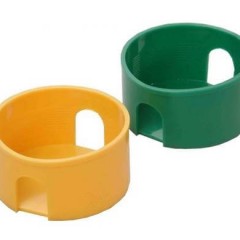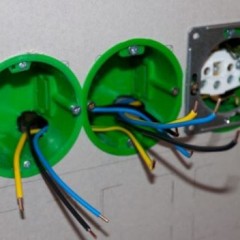How to connect a television outlet?
Wiring diagrams
You can connect a television outlet in one of two ways:
- a train;
- using the star connection diagram, which also requires the installation of a special device - a splitter
Both schemes have advantages and disadvantages, we will analyze them below.
With a train
First, let's visualize the connection diagram of a TV outlet with a cable:
It can be seen that this installation method implies the presence of bushing and one terminal outlet. In addition, looking at the diagram, the main minus of such a connection is immediately visible. Obviously, if a contact breaks at one of the points except the terminal one, it will not propagate further according to the scheme. Also, the incoming television signal is more stable and stronger at the first outlets. Further, it will weaken. However, this drawback is completely removed by the modern high level of the incoming signal.
The main advantage of this method is the cost and time saving for laying the antenna cable in a residential area.
Star pattern
As mentioned earlier, for this method of connecting a TV outlet, you must use a splitter. This device is a conditionally divider. It allows you to split and amplify the incoming signal into several equal amplified signals for further connection to a single television outlets. One of the advantages of this installation method is that the cost of single models is often less than passing and final.
Let's consider how to connect TV sockets with a star correctly:
It can be seen from the figure that, even if a signal disappears on one of the receivers, for example, due to a break or poor contact, this will not affect all other TVs. Thus, we can talk about some increased degree of reliability. And this, of course, is a plus of the circuit, even if it takes a tv cable a little more.
Installation instructions
Now we will tell you how to install a TV outlet.It is installed in a box pre-mounted in the wall with the antenna cable removed from it. Installing both a single and a double television outlet is no different.
In the photo from the right box you can see the outgoing television cable. After installation, it usually remains longer than necessary. We cut off the conductor so that there is a small margin, and it was convenient to make a connection.
Then you need to strip the TV cable to connect it directly to the wall outlet. Here it makes sense to dwell on it a little more. The structure of the conductor is clearly visible in the photo. Inside it is the main core, which, in fact, conducts a television signal. Next is a layer of internal insulation that separates the conductive core from the screen.
The screen consists of a layer of aluminum or copper braid and foil. It protects the main core from various interference and helps to get rid of unwanted interference, thus saving us from image distortion during viewing. And finally, on top of this is a protective insulation layer that protects the conductor from physical influences.
So for the connection we need to carefully remove the outer layer of insulation, twist the shielding layer, cut the inner insulation so that about 5-7 mm of the central core remains bare. It is her, as well as the shielding braid, that will need to be connected to a TV outlet.
We take the socket and slightly unscrew the screws at the cable connection point - this is a screw that secures the main core and screws that tighten the braid. We insert the core into a special connector and gradually tighten the screws so that it fits tightly in the clamps.
Next, you need to carefully lay the cable in the box, while correcting it so that it does not turn out to be the transferred housing of the outlet. We insert the case into the box and begin to tighten the spacer screws until it is firmly held in the wall. Then we snap on the decorative trim and observe the result of the work done.
The video clearly demonstrates all the stages of installation on the example of Legrand products:
Now you know how to install and connect a TV outlet with your own hands. As you can see, there are no difficulties in such work, the main thing is to decide on the installation scheme and route the cable to the right place!
It will be interesting to read:











